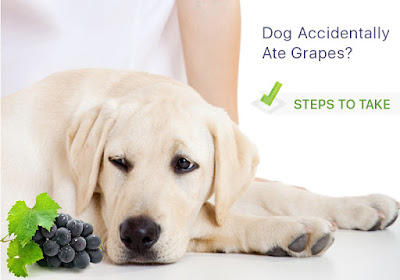It has
been well-documented that eating 32 grams of grapes per kg of dog can
be life-threatening for some dogs. A wise dog owner will always
ensure that his pooch is kept away from the sight of grapes. Although
the exact reason for the grapes to be toxic for dogs is still
unknown, it can result in renal failure also known as kidney failure
in dogs. In case, your dog accidentally ingests hands full of grapes
you can follow the steps given below to get him treated.
What steps To Take When Your Dog Ate Grapes?
Induce
him to vomit
If you
are sure that your doggie has ingested grapes the first step is to
induce vomiting in dog as soon as possible so that all the harmful
toxins in the grapes do not get absorbed by the dog. Use hydrogen
peroxide solution of one teaspoon for every 2 kg of bodyweight.
Warning:
Do not ever give more than 3 teaspoons in one go.
 |
If after the first administration the dog does not vomit; use the same dose again. Spare a time limit of ten minutes between each administration and never use this method for more than 3 times. If even after the third dose the dog does not vomit ask your veterinarian for suggestions. Never induce vomiting in a dog that has already vomited, is unconscious or having trouble while breathing. After initial care take him to the veterinarian.
Things To Do If Your Dog Accidentally Ingests Grapes
Use activated charcoal
Activated
charcoal is very handy in preventing toxins from entering the dog's
body. Hence, call the veterinarian and ask them about the quantity of
activated charcoal that needs to be administered to the dog. Some
dogs may not show much progress through this method and you may have
to take them to the veterinarian for immediate medical attention.
Certain sensitive dogs may require intensive care encompassing fluid
therapy and stomach wash.
Tell
everything you know about the incident to the veterinarian
Give
extensive information about the incident to the veterinarian so that
he/she can diagnose the pet properly. If the dog has vomited or had a
session of diarrhea, do not forget to collect the sample. This will
assist the vet to understand the problem and commence the treatment
quickly. He/she may run routine tests comprising of biochemistry
profile, urinalysis and a complete blood count. If the results show
enhanced blood calcium it can be due to hypercalcemia while higher
counts of phosphorus and creatinine point towards kidney problem.
Ultrasound will be conducted to determine the size of the kidney.
Commencement
of fluid therapy
Once the
vomiting has been successfully induced, a stomach wash and fluid
therapy will be carried out. For at least 2 days intravenous fluid
therapy will be given and drugs will be given to induce urine. If
urine is not produced within a short period of time your veterinarian
may place the dog on dialysis to give adequate time for his kidneys
to recover. During this period, he/she will monitor the dog's
chemicals regularly.
Timely
treatment and veteran's suggested dog supplies treatment is required to ensure that the toxins do not enter the
dog's body. Once the toxin has been removed entirely from the dog’s
body, he will be back to lead a normal life.

No comments:
Post a Comment